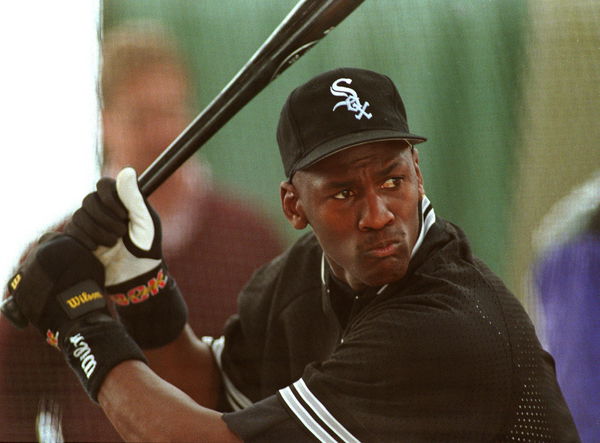
via Getty
CHICAGO, IL – FEBRUARY 7: American basketball star Michael Jordan takes batting practice 07 February 1994 with the Chicago White Sox in a bid to play with their baseball team. (Photo credit should read EUGENE GARCIA/AFP via Getty Images)

via Getty
CHICAGO, IL – FEBRUARY 7: American basketball star Michael Jordan takes batting practice 07 February 1994 with the Chicago White Sox in a bid to play with their baseball team. (Photo credit should read EUGENE GARCIA/AFP via Getty Images)
When we talk about Michael Jordan, what does it strike your mind? A basketball royalty, right? Six NBA championships, five MVPs, and a legacy that will echo throughout history. Despite that, for 18 months in the mid-1990s, Michael Jordan traded in his high-tops for cleats and gloves, chasing a childhood dream that had nothing to do with basketball. Probably that’s what legends do, try all they can. But does he carry the same legacy in baseball as he did in basketball?
While most of the world remembers it as a brief detour, his baseball journey was anything but a joke. It might just be one of the most underrated stories of resilience in sports history. The long-forgotten escapade was reignited when some long-lost footage of Jordan surfaced on YouTube.
But what transpired on the journey? The story began in 1993, right after Jordan won his third straight NBA title with the Bulls. Instead of celebrating, he was grieving. His father, James Jordan, had been murdered in cold blood earlier that summer. The loss hit him hard. His father had always dreamed of seeing him play professional baseball. At the peak of his powers, in his prime, Michael Jordan decided to shock the world in an electrifying transition. What’s that? He decided to retire from the NBA and sign a minor-league contract with the Chicago White Sox.
ADVERTISEMENT
Article continues below this ad

via Getty
CHICAGO, IL – MAY 19: Michael Jordan #23 of the Chicago Bulls poses for a photo with his 1998 MVP Trophy prior to a game against the Indiana Pacers Game Two of the Eastern Conference Finals on May 19, 1998 at the United Center in Chicago, Illinois. NOTE TO USER: User expressly acknowledges and agrees that, by downloading and/or using this photograph, user is consenting to the terms and conditions of the Getty Images License Agreement. Mandatory Copyright Notice: Copyright 1998 NBAE (Photo by Fernando Medina/NBAE via Getty Images)
To say that the sports world remained baffled would be a grave understatement. A serial winner vacating his throne to pursue a career in a sport he had not played in decades was inconceivable. But Michael Jordan, fueled by his indomitable spirit and competitive fire, did not care one bit and decided to honor his late father’s wish.
ADVERTISEMENT
Article continues below this ad
How did Jordan’s baseball journey pan out?
After he crossed the dotted line with the Chicago White Sox, he was sent to the Birmingham Barons, which was the White Sox’s Double-A affiliate. Don’t get it wrong, the Double-A is not just some low-level playing field, it is where the top prospects are sent to sharpen their repertoire before entering the big leagues. They sent Jordan there to ease him into the sport, but to his surprise, he wasn’t just playing with rookies, he was facing future MLB stars.
Jordan found his numbers unimpressive. After all, he is Jordan, and not meant to be average. He played a total of 127 games, in which he hit .202, which is sub-par, with 3 home runs, 51 RBIs, and 114 strikeouts. While his mediocre stats give you an impression of what his skills were as a baseball player, what it does not show is his relentless work ethic, his willingness to grind, and his freak natural athleticism which helped him steal 30 bases albeit struggling at the plate.
ADVERTISEMENT
Article continues below this ad
Despite challenges, Jordan showed flashes of promise and brilliance. During his stint at Arizona, in the fall league, he struck at .252, a marked improvement from his paltry .202. The progress was visible and real. However, tragedy struck. In 1995, an MLB strike left Jordan between a rock and a hard place. Jordan refused to be a part of a watered-down league. Jordan promptly picked up the phone, called the Bulls, and did what? Made one of the most iconic comebacks in sports history with the two-word press release: “I’m back.” Happy, right? Everyone was!
What’s your perspective on:
Did Michael Jordan's baseball stint prove his greatness, or was it a misstep in his career?
Have an interesting take?
In the end, one can reflect upon the baseball career and think, was its hall of fame worthy? The answer would be no. But in light of the circumstances, it serves as a testament to his character. He stepped out of his comfort zone and did not let fear be a factor in his pursuit of granting his late father’s wish. Isn’t that legendary?
ADVERTISEMENT
ADVERTISEMENT
ADVERTISEMENT
ADVERTISEMENT


Did Michael Jordan's baseball stint prove his greatness, or was it a misstep in his career?